Analysis of Piaget's Cognitive Development Theory: Toys and Games
VerifiedAdded on 2022/10/01
|8
|2090
|21
Report
AI Summary
This report delves into Jean Piaget's cognitive development theory, outlining its four key stages: sensorimotor, preoperational, concrete operational, and formal operational. The paper examines the characteristics of each stage, including how children perceive and interact with the world, and the cognitive milestones achieved. For each stage, the report suggests appropriate toys and games that facilitate cognitive development, providing descriptions of the toys and how they support learning. Furthermore, the report offers personal reflections on the toys and activities the author experienced during their own childhood, connecting these experiences to the theoretical concepts presented. The analysis emphasizes the importance of play and interaction with the environment in fostering cognitive growth, highlighting how different types of toys and activities can stimulate and enhance children's mental abilities at various developmental stages. The report concludes by reinforcing the critical role of toys and games in preparing children for future challenges by building logical thinking, language skills, and knowledge acquisition.
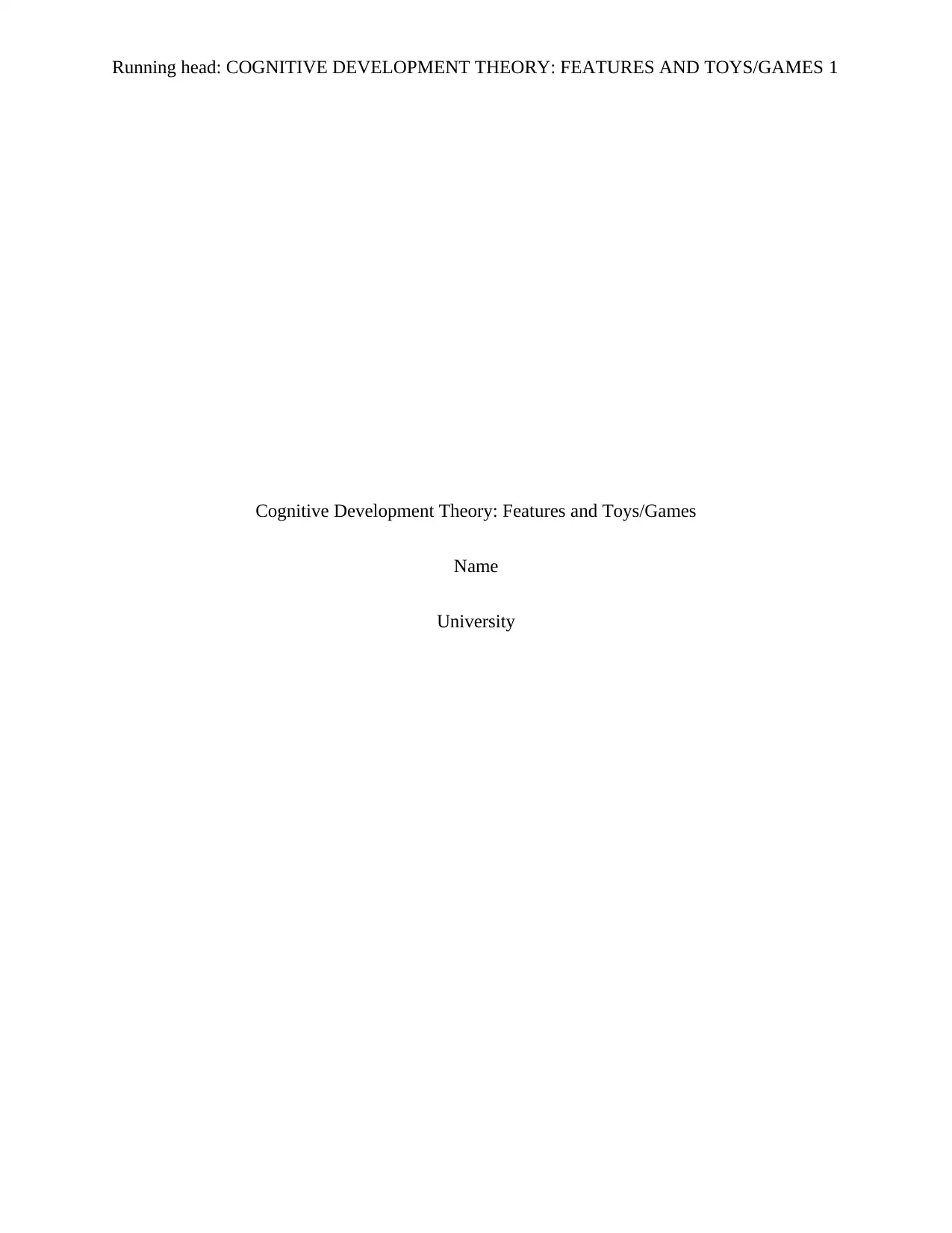
Running head: COGNITIVE DEVELOPMENT THEORY: FEATURES AND TOYS/GAMES 1
Cognitive Development Theory: Features and Toys/Games
Name
University
Cognitive Development Theory: Features and Toys/Games
Name
University
Paraphrase This Document
Need a fresh take? Get an instant paraphrase of this document with our AI Paraphraser
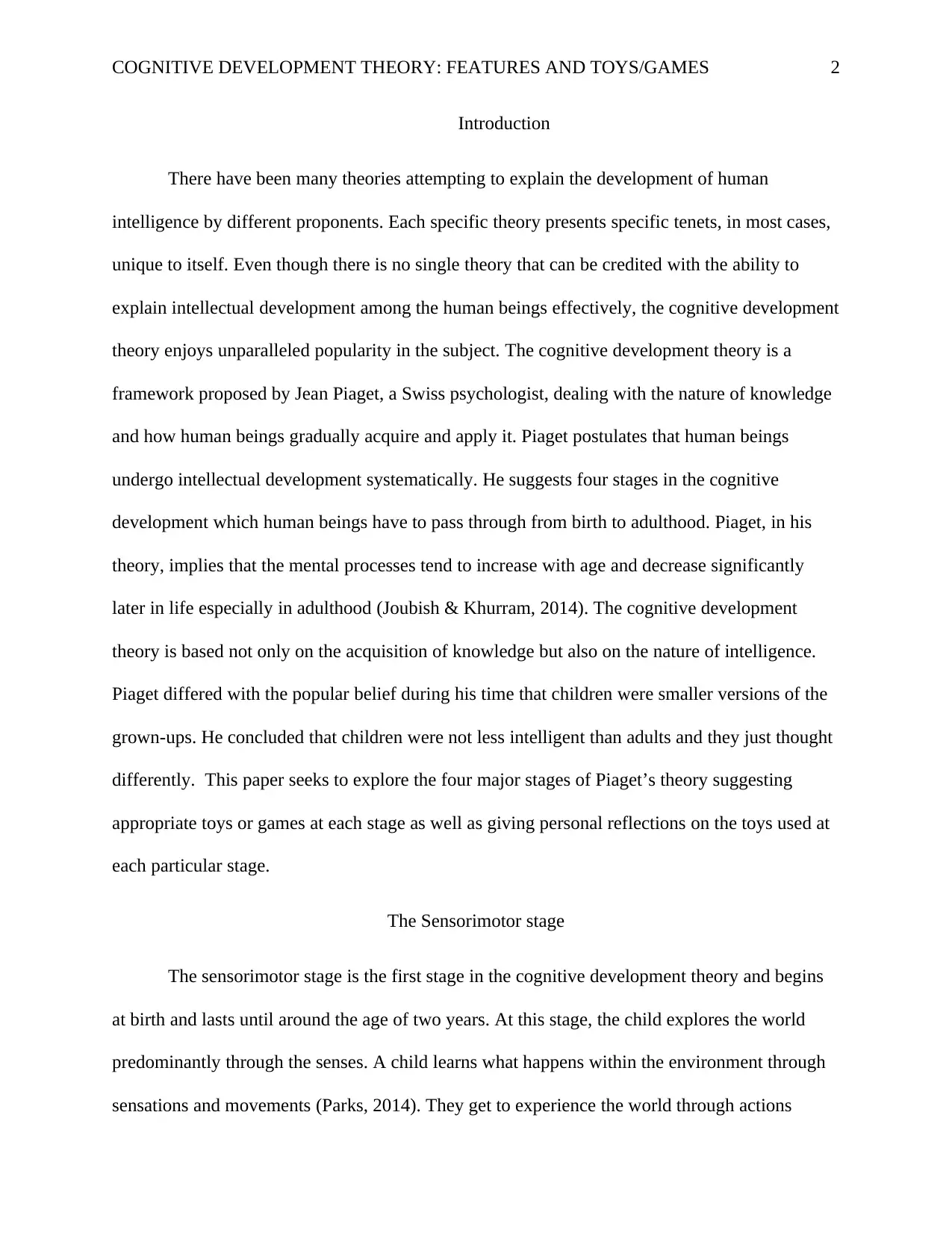
COGNITIVE DEVELOPMENT THEORY: FEATURES AND TOYS/GAMES 2
Introduction
There have been many theories attempting to explain the development of human
intelligence by different proponents. Each specific theory presents specific tenets, in most cases,
unique to itself. Even though there is no single theory that can be credited with the ability to
explain intellectual development among the human beings effectively, the cognitive development
theory enjoys unparalleled popularity in the subject. The cognitive development theory is a
framework proposed by Jean Piaget, a Swiss psychologist, dealing with the nature of knowledge
and how human beings gradually acquire and apply it. Piaget postulates that human beings
undergo intellectual development systematically. He suggests four stages in the cognitive
development which human beings have to pass through from birth to adulthood. Piaget, in his
theory, implies that the mental processes tend to increase with age and decrease significantly
later in life especially in adulthood (Joubish & Khurram, 2014). The cognitive development
theory is based not only on the acquisition of knowledge but also on the nature of intelligence.
Piaget differed with the popular belief during his time that children were smaller versions of the
grown-ups. He concluded that children were not less intelligent than adults and they just thought
differently. This paper seeks to explore the four major stages of Piaget’s theory suggesting
appropriate toys or games at each stage as well as giving personal reflections on the toys used at
each particular stage.
The Sensorimotor stage
The sensorimotor stage is the first stage in the cognitive development theory and begins
at birth and lasts until around the age of two years. At this stage, the child explores the world
predominantly through the senses. A child learns what happens within the environment through
sensations and movements (Parks, 2014). They get to experience the world through actions
Introduction
There have been many theories attempting to explain the development of human
intelligence by different proponents. Each specific theory presents specific tenets, in most cases,
unique to itself. Even though there is no single theory that can be credited with the ability to
explain intellectual development among the human beings effectively, the cognitive development
theory enjoys unparalleled popularity in the subject. The cognitive development theory is a
framework proposed by Jean Piaget, a Swiss psychologist, dealing with the nature of knowledge
and how human beings gradually acquire and apply it. Piaget postulates that human beings
undergo intellectual development systematically. He suggests four stages in the cognitive
development which human beings have to pass through from birth to adulthood. Piaget, in his
theory, implies that the mental processes tend to increase with age and decrease significantly
later in life especially in adulthood (Joubish & Khurram, 2014). The cognitive development
theory is based not only on the acquisition of knowledge but also on the nature of intelligence.
Piaget differed with the popular belief during his time that children were smaller versions of the
grown-ups. He concluded that children were not less intelligent than adults and they just thought
differently. This paper seeks to explore the four major stages of Piaget’s theory suggesting
appropriate toys or games at each stage as well as giving personal reflections on the toys used at
each particular stage.
The Sensorimotor stage
The sensorimotor stage is the first stage in the cognitive development theory and begins
at birth and lasts until around the age of two years. At this stage, the child explores the world
predominantly through the senses. A child learns what happens within the environment through
sensations and movements (Parks, 2014). They get to experience the world through actions
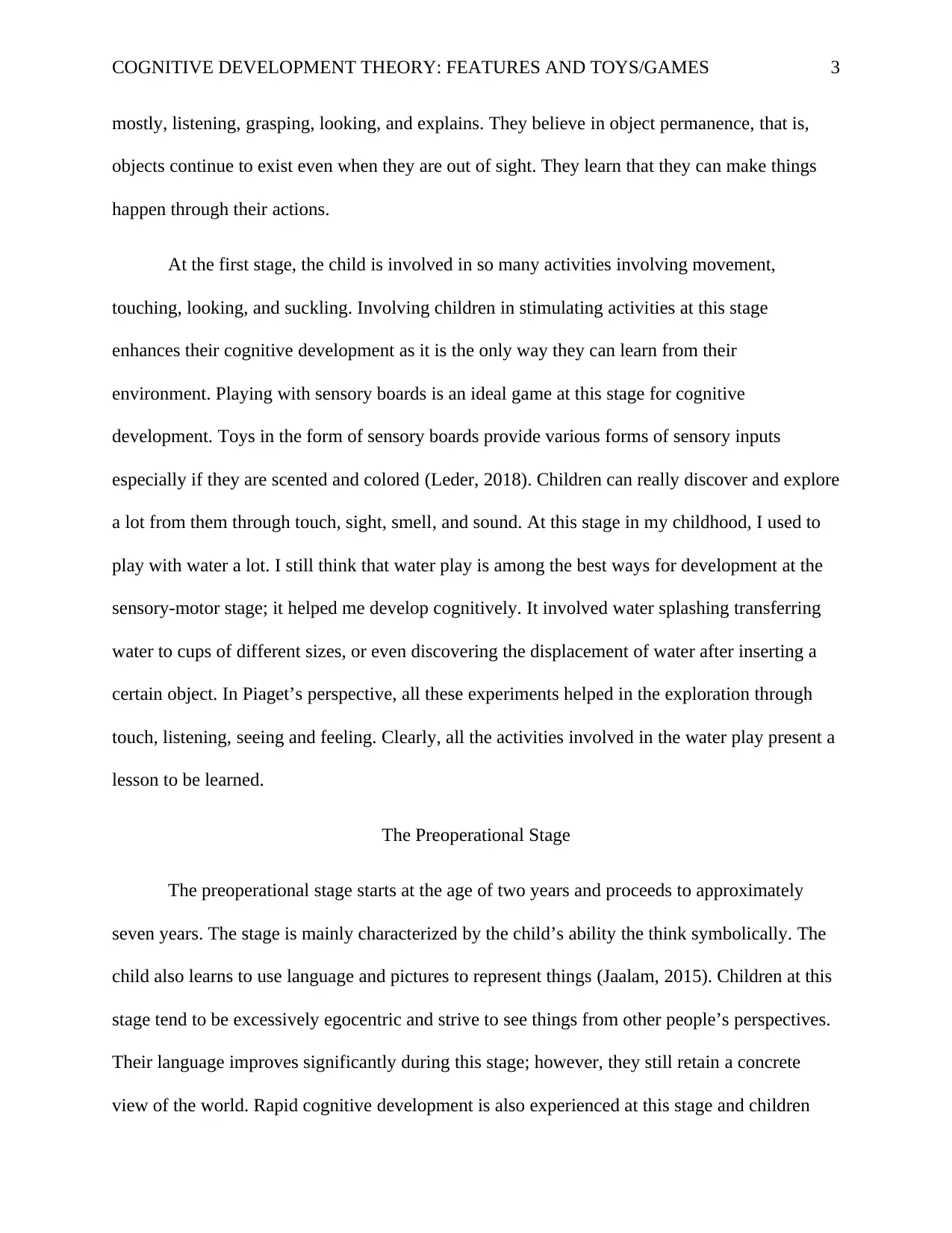
COGNITIVE DEVELOPMENT THEORY: FEATURES AND TOYS/GAMES 3
mostly, listening, grasping, looking, and explains. They believe in object permanence, that is,
objects continue to exist even when they are out of sight. They learn that they can make things
happen through their actions.
At the first stage, the child is involved in so many activities involving movement,
touching, looking, and suckling. Involving children in stimulating activities at this stage
enhances their cognitive development as it is the only way they can learn from their
environment. Playing with sensory boards is an ideal game at this stage for cognitive
development. Toys in the form of sensory boards provide various forms of sensory inputs
especially if they are scented and colored (Leder, 2018). Children can really discover and explore
a lot from them through touch, sight, smell, and sound. At this stage in my childhood, I used to
play with water a lot. I still think that water play is among the best ways for development at the
sensory-motor stage; it helped me develop cognitively. It involved water splashing transferring
water to cups of different sizes, or even discovering the displacement of water after inserting a
certain object. In Piaget’s perspective, all these experiments helped in the exploration through
touch, listening, seeing and feeling. Clearly, all the activities involved in the water play present a
lesson to be learned.
The Preoperational Stage
The preoperational stage starts at the age of two years and proceeds to approximately
seven years. The stage is mainly characterized by the child’s ability the think symbolically. The
child also learns to use language and pictures to represent things (Jaalam, 2015). Children at this
stage tend to be excessively egocentric and strive to see things from other people’s perspectives.
Their language improves significantly during this stage; however, they still retain a concrete
view of the world. Rapid cognitive development is also experienced at this stage and children
mostly, listening, grasping, looking, and explains. They believe in object permanence, that is,
objects continue to exist even when they are out of sight. They learn that they can make things
happen through their actions.
At the first stage, the child is involved in so many activities involving movement,
touching, looking, and suckling. Involving children in stimulating activities at this stage
enhances their cognitive development as it is the only way they can learn from their
environment. Playing with sensory boards is an ideal game at this stage for cognitive
development. Toys in the form of sensory boards provide various forms of sensory inputs
especially if they are scented and colored (Leder, 2018). Children can really discover and explore
a lot from them through touch, sight, smell, and sound. At this stage in my childhood, I used to
play with water a lot. I still think that water play is among the best ways for development at the
sensory-motor stage; it helped me develop cognitively. It involved water splashing transferring
water to cups of different sizes, or even discovering the displacement of water after inserting a
certain object. In Piaget’s perspective, all these experiments helped in the exploration through
touch, listening, seeing and feeling. Clearly, all the activities involved in the water play present a
lesson to be learned.
The Preoperational Stage
The preoperational stage starts at the age of two years and proceeds to approximately
seven years. The stage is mainly characterized by the child’s ability the think symbolically. The
child also learns to use language and pictures to represent things (Jaalam, 2015). Children at this
stage tend to be excessively egocentric and strive to see things from other people’s perspectives.
Their language improves significantly during this stage; however, they still retain a concrete
view of the world. Rapid cognitive development is also experienced at this stage and children
⊘ This is a preview!⊘
Do you want full access?
Subscribe today to unlock all pages.

Trusted by 1+ million students worldwide
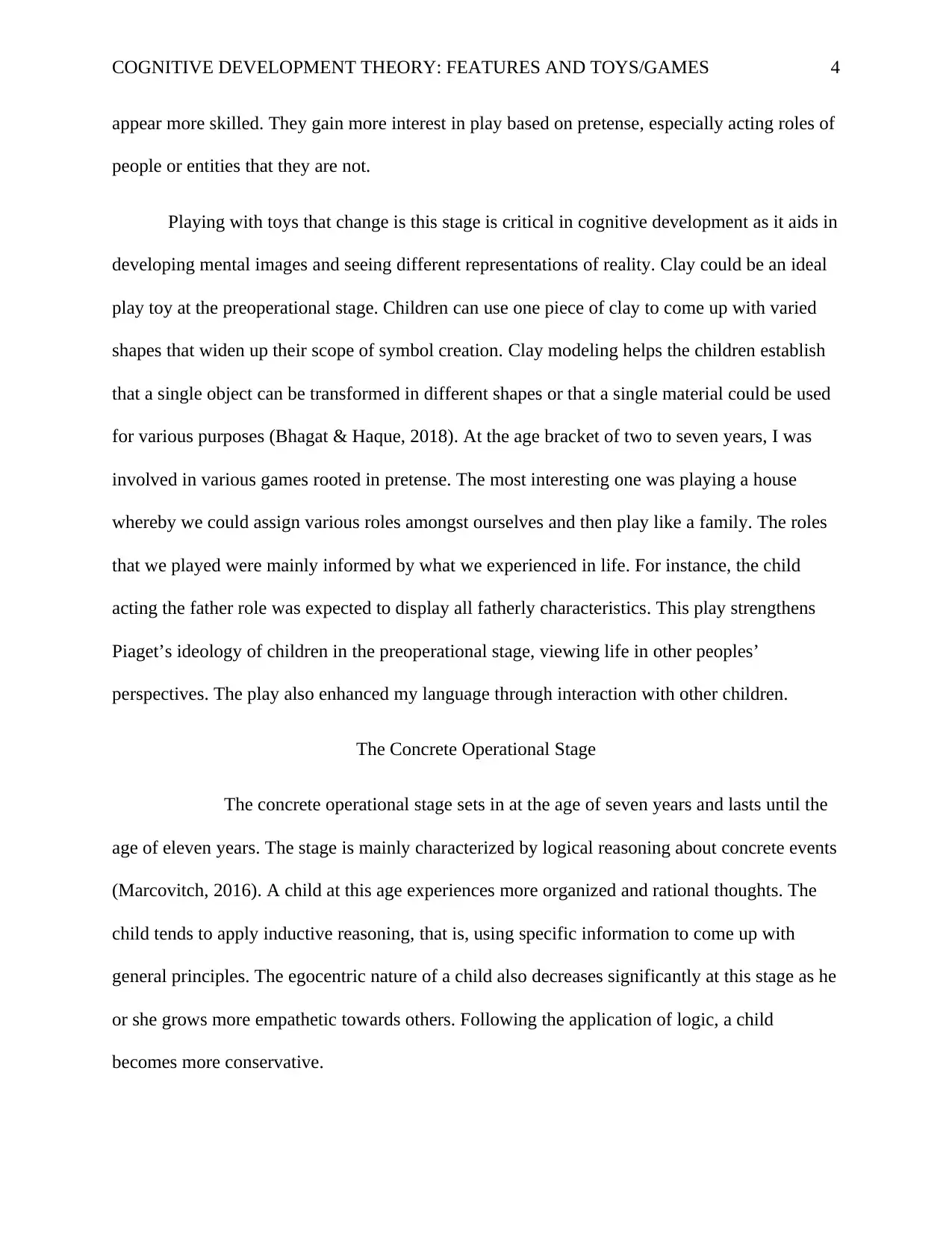
COGNITIVE DEVELOPMENT THEORY: FEATURES AND TOYS/GAMES 4
appear more skilled. They gain more interest in play based on pretense, especially acting roles of
people or entities that they are not.
Playing with toys that change is this stage is critical in cognitive development as it aids in
developing mental images and seeing different representations of reality. Clay could be an ideal
play toy at the preoperational stage. Children can use one piece of clay to come up with varied
shapes that widen up their scope of symbol creation. Clay modeling helps the children establish
that a single object can be transformed in different shapes or that a single material could be used
for various purposes (Bhagat & Haque, 2018). At the age bracket of two to seven years, I was
involved in various games rooted in pretense. The most interesting one was playing a house
whereby we could assign various roles amongst ourselves and then play like a family. The roles
that we played were mainly informed by what we experienced in life. For instance, the child
acting the father role was expected to display all fatherly characteristics. This play strengthens
Piaget’s ideology of children in the preoperational stage, viewing life in other peoples’
perspectives. The play also enhanced my language through interaction with other children.
The Concrete Operational Stage
The concrete operational stage sets in at the age of seven years and lasts until the
age of eleven years. The stage is mainly characterized by logical reasoning about concrete events
(Marcovitch, 2016). A child at this age experiences more organized and rational thoughts. The
child tends to apply inductive reasoning, that is, using specific information to come up with
general principles. The egocentric nature of a child also decreases significantly at this stage as he
or she grows more empathetic towards others. Following the application of logic, a child
becomes more conservative.
appear more skilled. They gain more interest in play based on pretense, especially acting roles of
people or entities that they are not.
Playing with toys that change is this stage is critical in cognitive development as it aids in
developing mental images and seeing different representations of reality. Clay could be an ideal
play toy at the preoperational stage. Children can use one piece of clay to come up with varied
shapes that widen up their scope of symbol creation. Clay modeling helps the children establish
that a single object can be transformed in different shapes or that a single material could be used
for various purposes (Bhagat & Haque, 2018). At the age bracket of two to seven years, I was
involved in various games rooted in pretense. The most interesting one was playing a house
whereby we could assign various roles amongst ourselves and then play like a family. The roles
that we played were mainly informed by what we experienced in life. For instance, the child
acting the father role was expected to display all fatherly characteristics. This play strengthens
Piaget’s ideology of children in the preoperational stage, viewing life in other peoples’
perspectives. The play also enhanced my language through interaction with other children.
The Concrete Operational Stage
The concrete operational stage sets in at the age of seven years and lasts until the
age of eleven years. The stage is mainly characterized by logical reasoning about concrete events
(Marcovitch, 2016). A child at this age experiences more organized and rational thoughts. The
child tends to apply inductive reasoning, that is, using specific information to come up with
general principles. The egocentric nature of a child also decreases significantly at this stage as he
or she grows more empathetic towards others. Following the application of logic, a child
becomes more conservative.
Paraphrase This Document
Need a fresh take? Get an instant paraphrase of this document with our AI Paraphraser
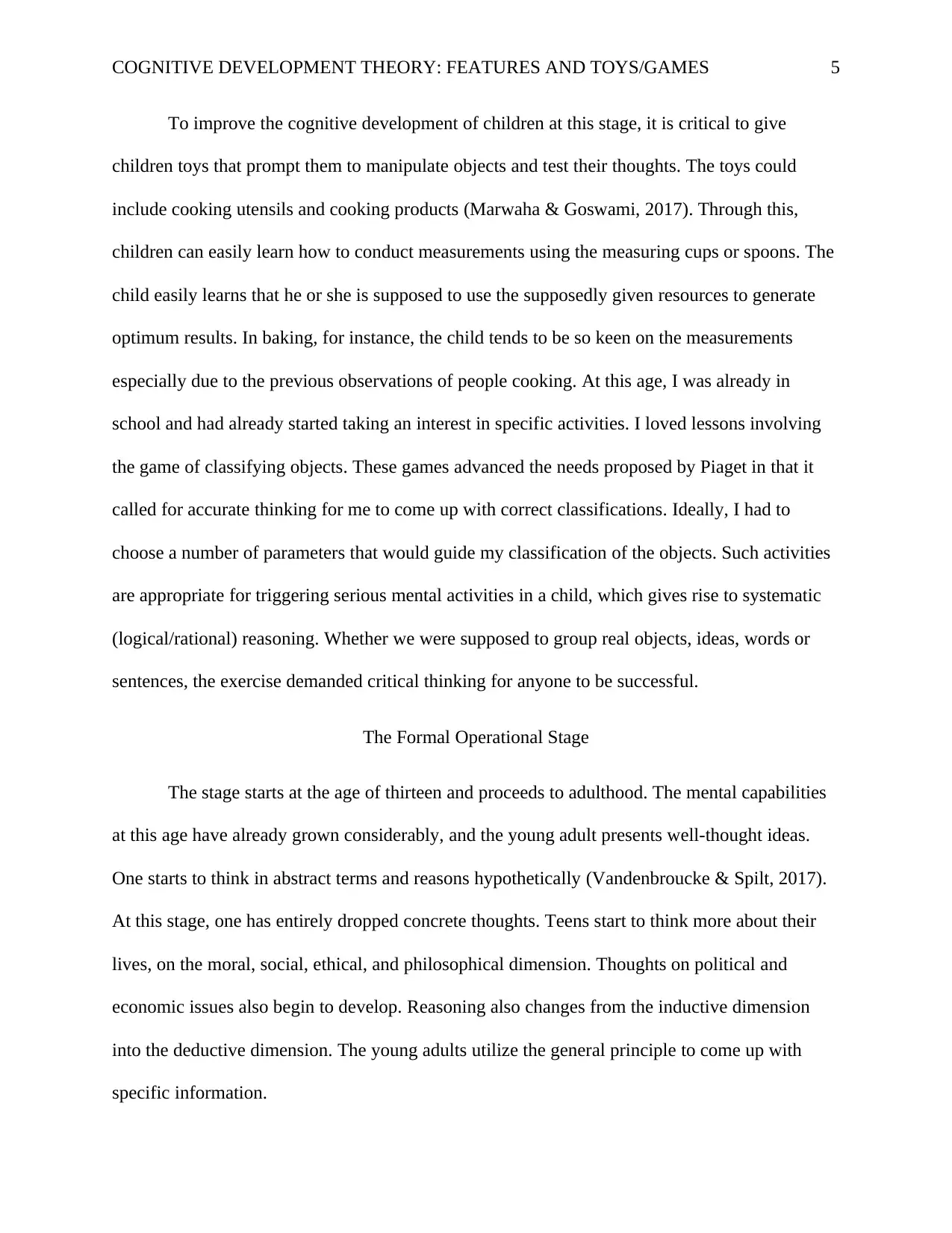
COGNITIVE DEVELOPMENT THEORY: FEATURES AND TOYS/GAMES 5
To improve the cognitive development of children at this stage, it is critical to give
children toys that prompt them to manipulate objects and test their thoughts. The toys could
include cooking utensils and cooking products (Marwaha & Goswami, 2017). Through this,
children can easily learn how to conduct measurements using the measuring cups or spoons. The
child easily learns that he or she is supposed to use the supposedly given resources to generate
optimum results. In baking, for instance, the child tends to be so keen on the measurements
especially due to the previous observations of people cooking. At this age, I was already in
school and had already started taking an interest in specific activities. I loved lessons involving
the game of classifying objects. These games advanced the needs proposed by Piaget in that it
called for accurate thinking for me to come up with correct classifications. Ideally, I had to
choose a number of parameters that would guide my classification of the objects. Such activities
are appropriate for triggering serious mental activities in a child, which gives rise to systematic
(logical/rational) reasoning. Whether we were supposed to group real objects, ideas, words or
sentences, the exercise demanded critical thinking for anyone to be successful.
The Formal Operational Stage
The stage starts at the age of thirteen and proceeds to adulthood. The mental capabilities
at this age have already grown considerably, and the young adult presents well-thought ideas.
One starts to think in abstract terms and reasons hypothetically (Vandenbroucke & Spilt, 2017).
At this stage, one has entirely dropped concrete thoughts. Teens start to think more about their
lives, on the moral, social, ethical, and philosophical dimension. Thoughts on political and
economic issues also begin to develop. Reasoning also changes from the inductive dimension
into the deductive dimension. The young adults utilize the general principle to come up with
specific information.
To improve the cognitive development of children at this stage, it is critical to give
children toys that prompt them to manipulate objects and test their thoughts. The toys could
include cooking utensils and cooking products (Marwaha & Goswami, 2017). Through this,
children can easily learn how to conduct measurements using the measuring cups or spoons. The
child easily learns that he or she is supposed to use the supposedly given resources to generate
optimum results. In baking, for instance, the child tends to be so keen on the measurements
especially due to the previous observations of people cooking. At this age, I was already in
school and had already started taking an interest in specific activities. I loved lessons involving
the game of classifying objects. These games advanced the needs proposed by Piaget in that it
called for accurate thinking for me to come up with correct classifications. Ideally, I had to
choose a number of parameters that would guide my classification of the objects. Such activities
are appropriate for triggering serious mental activities in a child, which gives rise to systematic
(logical/rational) reasoning. Whether we were supposed to group real objects, ideas, words or
sentences, the exercise demanded critical thinking for anyone to be successful.
The Formal Operational Stage
The stage starts at the age of thirteen and proceeds to adulthood. The mental capabilities
at this age have already grown considerably, and the young adult presents well-thought ideas.
One starts to think in abstract terms and reasons hypothetically (Vandenbroucke & Spilt, 2017).
At this stage, one has entirely dropped concrete thoughts. Teens start to think more about their
lives, on the moral, social, ethical, and philosophical dimension. Thoughts on political and
economic issues also begin to develop. Reasoning also changes from the inductive dimension
into the deductive dimension. The young adults utilize the general principle to come up with
specific information.
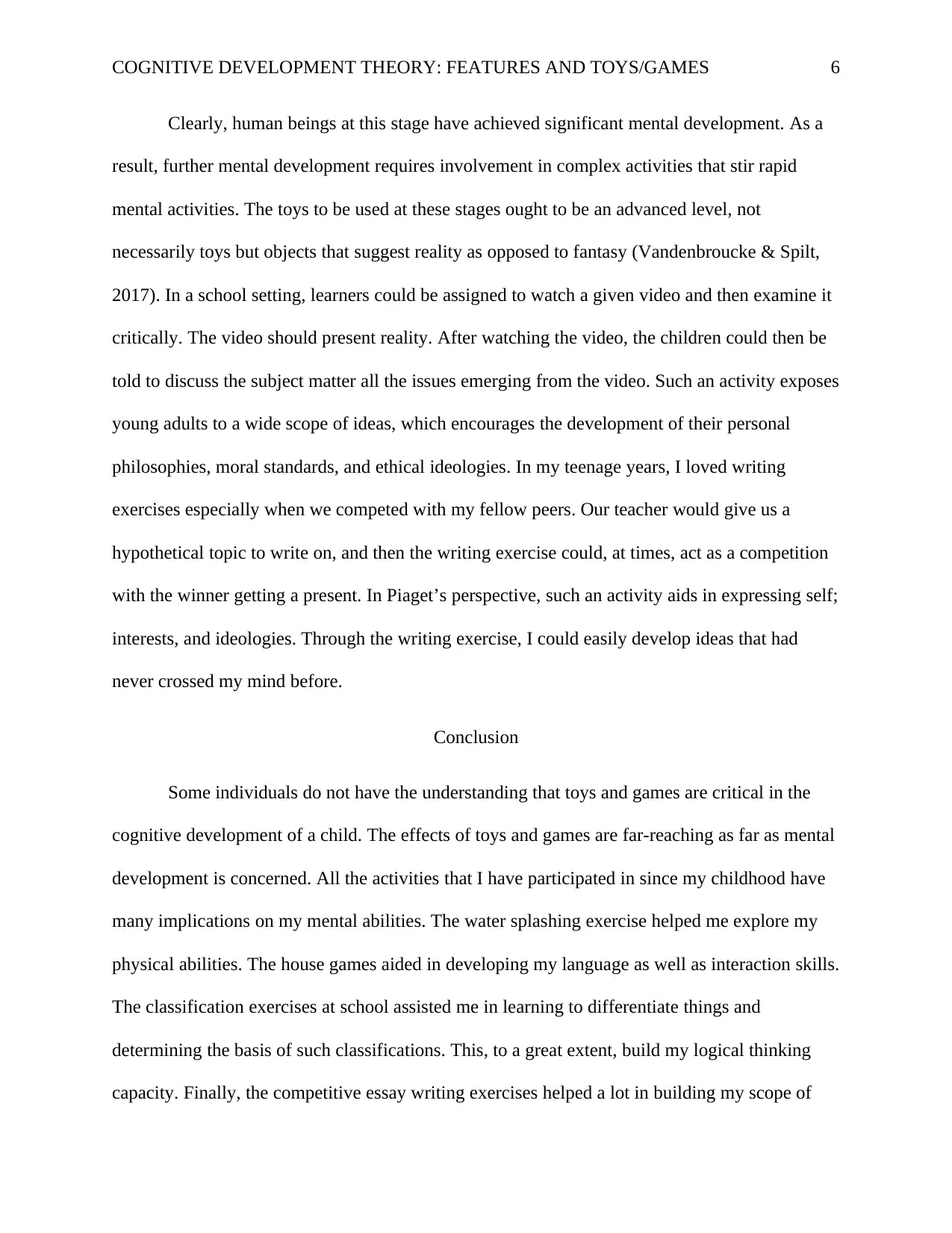
COGNITIVE DEVELOPMENT THEORY: FEATURES AND TOYS/GAMES 6
Clearly, human beings at this stage have achieved significant mental development. As a
result, further mental development requires involvement in complex activities that stir rapid
mental activities. The toys to be used at these stages ought to be an advanced level, not
necessarily toys but objects that suggest reality as opposed to fantasy (Vandenbroucke & Spilt,
2017). In a school setting, learners could be assigned to watch a given video and then examine it
critically. The video should present reality. After watching the video, the children could then be
told to discuss the subject matter all the issues emerging from the video. Such an activity exposes
young adults to a wide scope of ideas, which encourages the development of their personal
philosophies, moral standards, and ethical ideologies. In my teenage years, I loved writing
exercises especially when we competed with my fellow peers. Our teacher would give us a
hypothetical topic to write on, and then the writing exercise could, at times, act as a competition
with the winner getting a present. In Piaget’s perspective, such an activity aids in expressing self;
interests, and ideologies. Through the writing exercise, I could easily develop ideas that had
never crossed my mind before.
Conclusion
Some individuals do not have the understanding that toys and games are critical in the
cognitive development of a child. The effects of toys and games are far-reaching as far as mental
development is concerned. All the activities that I have participated in since my childhood have
many implications on my mental abilities. The water splashing exercise helped me explore my
physical abilities. The house games aided in developing my language as well as interaction skills.
The classification exercises at school assisted me in learning to differentiate things and
determining the basis of such classifications. This, to a great extent, build my logical thinking
capacity. Finally, the competitive essay writing exercises helped a lot in building my scope of
Clearly, human beings at this stage have achieved significant mental development. As a
result, further mental development requires involvement in complex activities that stir rapid
mental activities. The toys to be used at these stages ought to be an advanced level, not
necessarily toys but objects that suggest reality as opposed to fantasy (Vandenbroucke & Spilt,
2017). In a school setting, learners could be assigned to watch a given video and then examine it
critically. The video should present reality. After watching the video, the children could then be
told to discuss the subject matter all the issues emerging from the video. Such an activity exposes
young adults to a wide scope of ideas, which encourages the development of their personal
philosophies, moral standards, and ethical ideologies. In my teenage years, I loved writing
exercises especially when we competed with my fellow peers. Our teacher would give us a
hypothetical topic to write on, and then the writing exercise could, at times, act as a competition
with the winner getting a present. In Piaget’s perspective, such an activity aids in expressing self;
interests, and ideologies. Through the writing exercise, I could easily develop ideas that had
never crossed my mind before.
Conclusion
Some individuals do not have the understanding that toys and games are critical in the
cognitive development of a child. The effects of toys and games are far-reaching as far as mental
development is concerned. All the activities that I have participated in since my childhood have
many implications on my mental abilities. The water splashing exercise helped me explore my
physical abilities. The house games aided in developing my language as well as interaction skills.
The classification exercises at school assisted me in learning to differentiate things and
determining the basis of such classifications. This, to a great extent, build my logical thinking
capacity. Finally, the competitive essay writing exercises helped a lot in building my scope of
⊘ This is a preview!⊘
Do you want full access?
Subscribe today to unlock all pages.

Trusted by 1+ million students worldwide

COGNITIVE DEVELOPMENT THEORY: FEATURES AND TOYS/GAMES 7
knowledge as well as thinking capabilities. Critically, the role of toys and games in child-
learning cannot be ruled out in their cognitive development. They play a critical role in preparing
a life-ready young adult who can make sound judgements on different occasions.
knowledge as well as thinking capabilities. Critically, the role of toys and games in child-
learning cannot be ruled out in their cognitive development. They play a critical role in preparing
a life-ready young adult who can make sound judgements on different occasions.
Paraphrase This Document
Need a fresh take? Get an instant paraphrase of this document with our AI Paraphraser
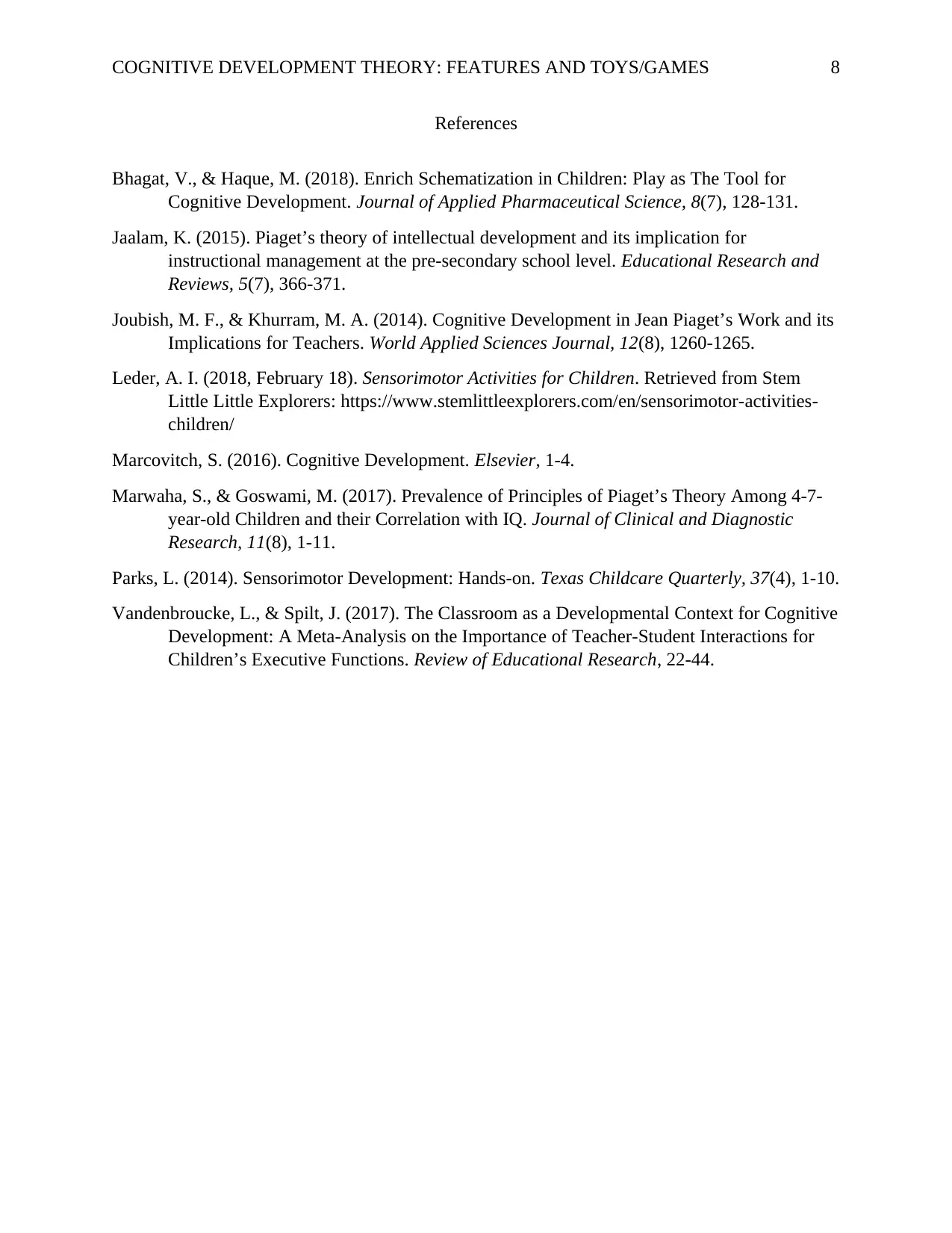
COGNITIVE DEVELOPMENT THEORY: FEATURES AND TOYS/GAMES 8
References
Bhagat, V., & Haque, M. (2018). Enrich Schematization in Children: Play as The Tool for
Cognitive Development. Journal of Applied Pharmaceutical Science, 8(7), 128-131.
Jaalam, K. (2015). Piaget’s theory of intellectual development and its implication for
instructional management at the pre-secondary school level. Educational Research and
Reviews, 5(7), 366-371.
Joubish, M. F., & Khurram, M. A. (2014). Cognitive Development in Jean Piaget’s Work and its
Implications for Teachers. World Applied Sciences Journal, 12(8), 1260-1265.
Leder, A. I. (2018, February 18). Sensorimotor Activities for Children. Retrieved from Stem
Little Little Explorers: https://www.stemlittleexplorers.com/en/sensorimotor-activities-
children/
Marcovitch, S. (2016). Cognitive Development. Elsevier, 1-4.
Marwaha, S., & Goswami, M. (2017). Prevalence of Principles of Piaget’s Theory Among 4-7-
year-old Children and their Correlation with IQ. Journal of Clinical and Diagnostic
Research, 11(8), 1-11.
Parks, L. (2014). Sensorimotor Development: Hands-on. Texas Childcare Quarterly, 37(4), 1-10.
Vandenbroucke, L., & Spilt, J. (2017). The Classroom as a Developmental Context for Cognitive
Development: A Meta-Analysis on the Importance of Teacher-Student Interactions for
Children’s Executive Functions. Review of Educational Research, 22-44.
References
Bhagat, V., & Haque, M. (2018). Enrich Schematization in Children: Play as The Tool for
Cognitive Development. Journal of Applied Pharmaceutical Science, 8(7), 128-131.
Jaalam, K. (2015). Piaget’s theory of intellectual development and its implication for
instructional management at the pre-secondary school level. Educational Research and
Reviews, 5(7), 366-371.
Joubish, M. F., & Khurram, M. A. (2014). Cognitive Development in Jean Piaget’s Work and its
Implications for Teachers. World Applied Sciences Journal, 12(8), 1260-1265.
Leder, A. I. (2018, February 18). Sensorimotor Activities for Children. Retrieved from Stem
Little Little Explorers: https://www.stemlittleexplorers.com/en/sensorimotor-activities-
children/
Marcovitch, S. (2016). Cognitive Development. Elsevier, 1-4.
Marwaha, S., & Goswami, M. (2017). Prevalence of Principles of Piaget’s Theory Among 4-7-
year-old Children and their Correlation with IQ. Journal of Clinical and Diagnostic
Research, 11(8), 1-11.
Parks, L. (2014). Sensorimotor Development: Hands-on. Texas Childcare Quarterly, 37(4), 1-10.
Vandenbroucke, L., & Spilt, J. (2017). The Classroom as a Developmental Context for Cognitive
Development: A Meta-Analysis on the Importance of Teacher-Student Interactions for
Children’s Executive Functions. Review of Educational Research, 22-44.
1 out of 8
Related Documents
Your All-in-One AI-Powered Toolkit for Academic Success.
+13062052269
info@desklib.com
Available 24*7 on WhatsApp / Email
![[object Object]](/_next/static/media/star-bottom.7253800d.svg)
Unlock your academic potential
Copyright © 2020–2025 A2Z Services. All Rights Reserved. Developed and managed by ZUCOL.





